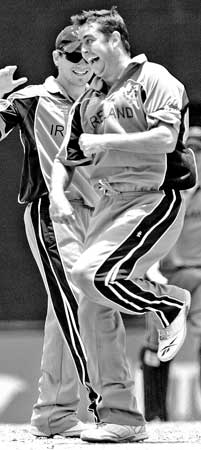
What might have been
Yet, many subjects about the tournament are being discussed -- from the playing angle to incidents to the personalities who succeeded and failed. For a few years the discussions will go on until it simmers down to the most essential and memorable factors.
Few perhaps too many will discuss the composition of the tournament. Since its inception in 1975, the format has changed, until now it is, in terms of the period of time, pretty close to the Football World Cup. A number of critics felt it was too long and that there were teams who were not capable of making any impression at this level The Chief Executive of the ICC, Malcolm Speed, had at some stage while the tournament was in progress mentioned that the format will not be changed in 2011. There is a long time for that and ideas must be discussed before the next event. In my opinion the most unfortunate of happenings (from a cricket point of view) was the elimination of India and Pakistan from the group stage. Say what you may but the tournament lost a lot of spark with their early exit. These, were two teams that should have been in the ‘super-eight series’. There would have been many closer games and even the possibility of one or both teams going through to the semi final. Up until the second of the ODI series in progress India and Bangladesh had met on sixteen occasions. India winning fourteen and Bangladesh two! Give all credit to Bangladesh for their performance on the day, but it is fair to be pushed out of a World Cup, after four years of preparation and noteworthy performances on the strength of one result? Similarly, Pakistan should beat Ireland on nine out of ten occasions. Is this grouping system justified? Of the sixteen teams six were out amongst the International playing nations. Zimbabwe is not playing test cricket at the moment and they should also be moved to the opposite side of the scale, making it nine and seven. That somehow does not indicate a proper balance for the major event in the one day cricket calendar. On performance the two weakest teams were Canada and Bermuda, although both teams were seeded higher than Holland who were the bottom seeds (16), at the commencement of the tournament. Canada played in the very first World Cup in 1975, but sadly, thirty two years later have not improved at all! Bermuda, were just not up to it and sorry, they should not have been there. Let’s visualize this tournament being played with fourteen teams and the first round being in two groups of seven teams in each. That gives every team six games. Above all it gives the good teams to have the unexpected bad day yet bounce back to be in the top four to get to round two. This round could still be called the ‘super-eight series’ as it consists of eight teams. Should that have been the system for the concluded World Cup, with the then seedings, the two groups would have been divided in this manner. Group One: Australia (1), Pakistan (4), South Africa (5), England (7), Kenya (10), Scotland (12), Holland (14). Group Two: Sri Lanka (2), New Zealand (3), West Indies (6), India (8), Zimbabwe (9), Bangladesh (10), Ireland (13) The final was reduced to thirty eight overs and then to thirty six in the end. The present rules permit for a final to be reduced to twenty overs per side. This was the first World Cup final where the overs were reduced. A far cry from 1975 when nearly one hundred and twenty overs were bowled and the game finished around nine o’clock in the night! The alarm bells have tolled. It is time to take a look at the playing times and conditions for the final. Over the years the tournament has undergone plenty of changes to get to its present formula. Much fine tuning has been done. That must continue and playing fourteen teams in two groups in round one must be considered. The dust has settled in the Caribbean, it should be back to the drawing board. |
|| Front
Page | News | Editorial | Columns | Sports | Plus | Financial
Times | International | Mirror | TV
Times | Funday
Times || |
| |
Copyright
2007 Wijeya
Newspapers Ltd.Colombo. Sri Lanka. |
 Two weeks have gone by since the conclusion of the World Cup and cricket as usual has got moving. The English county season is underway in glorious late spring weather. India and Bangladesh have got a one day series underway.
Two weeks have gone by since the conclusion of the World Cup and cricket as usual has got moving. The English county season is underway in glorious late spring weather. India and Bangladesh have got a one day series underway. 